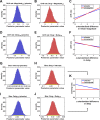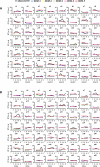A process model account of the role of dopamine in intertemporal choice
- PMID: 36884013
- PMCID: PMC9995109
- DOI: 10.7554/eLife.83734
A process model account of the role of dopamine in intertemporal choice
Abstract
Theoretical accounts disagree on the role of dopamine in intertemporal choice and assume that dopamine either promotes delay of gratification by increasing the preference for larger rewards or that dopamine reduces patience by enhancing the sensitivity to waiting costs. Here, we reconcile these conflicting accounts by providing empirical support for a novel process model according to which dopamine contributes to two dissociable components of the decision process, evidence accumulation and starting bias. We re-analyzed a previously published data set where intertemporal decisions were made either under the D2 antagonist amisulpride or under placebo by fitting a hierarchical drift diffusion model that distinguishes between dopaminergic effects on the speed of evidence accumulation and the starting point of the accumulation process. Blocking dopaminergic neurotransmission not only strengthened the sensitivity to whether a reward is perceived as worth the delay costs during evidence accumulation (drift rate) but also attenuated the impact of waiting costs on the starting point of the evidence accumulation process (bias). In contrast, re-analyzing data from a D1 agonist study provided no evidence for a causal involvement of D1R activation in intertemporal choices. Taken together, our findings support a novel, process-based account of the role of dopamine for cost-benefit decision making, highlight the potential benefits of process-informed analyses, and advance our understanding of dopaminergic contributions to decision making.
Trial registration: ClinicalTrials.gov NCT03181841.
Keywords: amisulpride; delay discounting; dopamine; drift diffusion model; human; neuroscience; proximity; reward.
© 2023, Soutschek and Tobler.
Conflict of interest statement
AS, PT No competing interests declared
Figures





Update of
- doi: 10.1101/2022.10.24.513522
Similar articles
-
Dopaminergic Modulation of Human Intertemporal Choice: A Diffusion Model Analysis Using the D2-Receptor Antagonist Haloperidol.J Neurosci. 2020 Oct 7;40(41):7936-7948. doi: 10.1523/JNEUROSCI.0592-20.2020. Epub 2020 Sep 18. J Neurosci. 2020. PMID: 32948675 Free PMC article.
-
An improved within-session self-adjusting delay discounting procedure for the study of choice impulsivity in rats.Psychopharmacology (Berl). 2018 Jul;235(7):2123-2135. doi: 10.1007/s00213-018-4911-y. Epub 2018 Apr 30. Psychopharmacology (Berl). 2018. PMID: 29713789
-
Pre-supplementary motor area strengthens reward sensitivity in intertemporal choice.Neuroimage. 2024 Oct 1;299:120838. doi: 10.1016/j.neuroimage.2024.120838. Epub 2024 Sep 5. Neuroimage. 2024. PMID: 39241899
-
The costs of delay: waiting versus postponing in intertemporal choice.J Exp Anal Behav. 2013 May;99(3):362-77. doi: 10.1002/jeab.18. Epub 2013 Feb 14. J Exp Anal Behav. 2013. PMID: 23413105 Review.
-
Toward a Unifying Account of Dopamine's Role in Cost-Benefit Decision Making.Biol Psychiatry Glob Open Sci. 2022 Mar 8;3(2):179-186. doi: 10.1016/j.bpsgos.2022.02.010. eCollection 2023 Apr. Biol Psychiatry Glob Open Sci. 2022. PMID: 37124350 Free PMC article. Review.
Cited by
-
Dopamine and acetylcholine have distinct roles in delay- and effort-based decision-making in humans.PLoS Biol. 2024 Jul 12;22(7):e3002714. doi: 10.1371/journal.pbio.3002714. eCollection 2024 Jul. PLoS Biol. 2024. PMID: 38995982 Free PMC article.
-
Neural reward system reflects individual value comparison strategy in cost-benefit decisions.Commun Biol. 2024 Nov 12;7(1):1488. doi: 10.1038/s42003-024-07210-5. Commun Biol. 2024. PMID: 39533059 Free PMC article.
-
Mindfulness training reduces the preference for proenvironmental outcomes.Sci Rep. 2024 Nov 27;14(1):29526. doi: 10.1038/s41598-024-79137-0. Sci Rep. 2024. PMID: 39604522 Free PMC article.
References
Publication types
MeSH terms
Substances
Associated data
LinkOut - more resources
Full Text Sources
Medical

